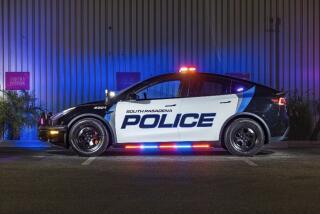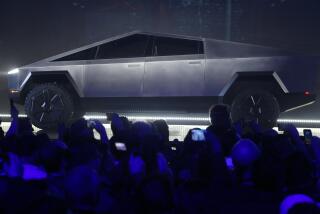Police Mourning Imminent Demise of Popular Cruiser
- Share via
The Chevrolet Caprice, that mammoth bubble-shaped police cruiser whose imposing profile gets drivers eyeing their speedometers and gently tapping the brakes, is about to turn in its badge.
General Motors will halt production of the rear-wheel-drive “land yacht” at the end of next year, forcing police agencies to find replacement models and prompting some officers to reflect sadly on the demise of the venerable vehicle, which has been around for more than 20 years.
Because patrol officers spend eight hours or more a day in their roomy vehicles, finding a successor to the Caprice has generated interest and regret in squad rooms around the county.
“We’re still a little bit in shock about this,” lamented Sgt. Andy Gonis of the Newport Beach Police Department, one of more than a dozen Orange County agencies loyal to the Caprice. “We’re sorry to see it go.”
Some law enforcement agencies, including the Sheriff’s Department and the Huntington Beach Police Department, plan to continue purchasing Caprices until the last ones roll off assembly lines next year.
After that, Ford’s Crown Victoria sedan--now used by Costa Mesa police, the California Highway Patrol and others--is likely to be the only full-size police cruiser on the market.
General Motors will offer a police version of its smaller Chevrolet Lumina sedan and perhaps a police sport-utility vehicle. But some police departments are not excited about those alternatives.
Officials said they are reluctant to purchase mid-size sedans such as the Lumina because the vehicles might not be able to comfortably accommodate patrol officers and all their equipment.
“For the officer, the police car is an office,” said Lt. Ron Wilkerson of the Sheriff’s Department. “You have cameras, computers, radios in there. . . . If you drive long distances in a smaller car, it can be fatiguing. And in this occupation, you don’t need other factors that can cause fatigue.”
Mid-size patrol cars can also prove more difficult for transporting arrestees, officers said, because of limited room in the back seat, especially after police install the protective safety cage.
“You don’t want to shoehorn people,” said Lt. Philip Marshall of the Westminster Police Department. “If you can keep a prisoner happy and cooperative, it makes it easier when you interview him. And the jailer doesn’t have to put up with an irritated prisoner when he gets out of the car.”
While a few departments use sport-utility models for K-9 squads and park patrols, officials said, they are unlikely to employ them for regular duty because the vehicles have a high center of gravity and can become unstable during high-speed chases.
The Crown Victoria would seem like the natural replacement for the Caprice. Both sedans can travel at speeds in excess of 120 m.p.h., and each weighs nearly 4,000 pounds. But officials expressed concern that Ford might raise the price once its competition is gone. Police versions of the Caprice and Crown Victoria now sell for $18,000 to $21,000.
The Caprice has been a mainstay of the police motor pool for more than two decades, even as consumer demand for full-size, rear-wheel-drive cars slowly evaporated.
General Motors plans to produce more popular trucks and vans at the Texas plant that now manufactures Caprices, as well as Cadillac Fleetwoods and Buick Roadmasters.
The Caprice wins high marks from officers for its interior room, powerful motor and handling. But its ultra-rounded design is another matter.
Some see a sleek and aerodynamic car, while others see an unfortunate cross between a flying saucer and a lowrider.
When Chevrolet rolled out the new Caprice design about five years ago, “it looked very strange,” Gonis admitted.
The new design “generated a lot of interest,” added Wilkerson of the Sheriff’s Department. “It was either love or hate. . . . But [the Caprice] is a very good vehicle. It does the job. We hate to lose it.”
The Caprice police edition includes heavy-duty suspension and cooling systems and a powerful motor.
Officers can put 100,000 miles on a patrol car within about three years, so it is likely that the familiar black-and-white Caprice will begin disappearing from the road by the end of the decade.
Police insist they will adapt to life without the lumbering sedan, just as they did in the late 1980s when Chrysler discontinued its police cruiser model.
“We’ve changed cars over the years,” Gonis said. But, he noted, “it’s the end of an era.”
More to Read
Sign up for Essential California
The most important California stories and recommendations in your inbox every morning.
You may occasionally receive promotional content from the Los Angeles Times.














